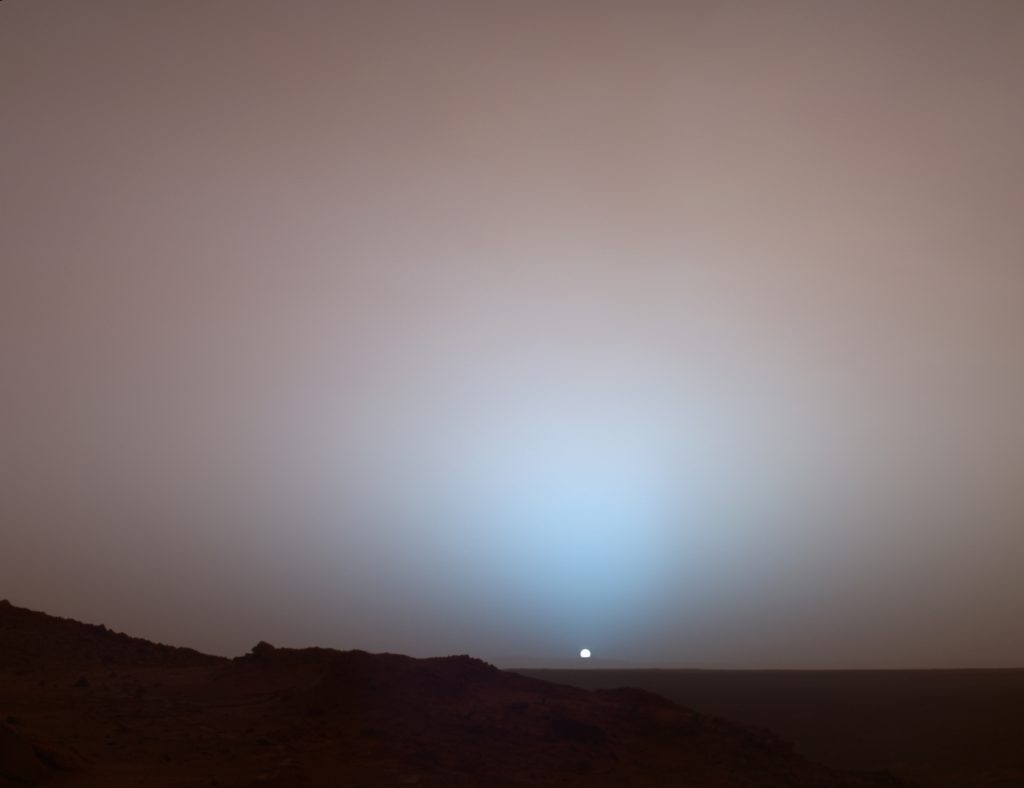Earth/Martian Sunsets
The sky is blue and sunsets are red… on Earth. Have you ever wondered why? Or why clouds are white and sand storms make the sky red. Things turn even more weird when moving to Mars: the regular sky there is red and twilight and dawn are definitely not red and can be bluish. By a simple experiment you will easily get some basic light scattering concepts, which will allow you to understand the blue-red exchange of sky colors between The Earth and Mars.
TIME
1 hour
MATERIALS
- Dark room
- Flashlight
- Pipette
- Polarizer
- Transparent rectangular container (e.g., a fishtank)
- 250 mL of whole milk
- 10 L of water
OBJETIVES
- Developing observation skills
- Knowing the visible light spectrum
- Understand Rayleigh and Mie light scattering
- Finding out about linear polarization

INSTRUCTIONS
- Fill in the container with 10 L of clean water.
- Put some white paper on one of the largest faces A or just place it next to a white wall.
- Turn lights off
- Illuminate from side B of the tank so light travels in its longest direction.
- Check how light travels through towards the other side of the container B’ and comes out with the same brightness and color as it entered.
- Add 30 mL of milk to the tank.
- Illuminate again.
- Look at face A’ of the tank. You must see a gradual change of color of the liquid in the container: bluish close to the flashlight and reddish at the other end.
- Now change the lantern by a laser and look from the same side as before. But this time look through a polarizer and turn it over. You must see a significant change of brightness of light through the polarizer when turning it.
- Add more the milk. Now you must see that less light is able to travel through the container and blue scattered light is only at the beginning

Tank with water (and milk) illuminated from one side
EXPLANATION
Milk forms little droplets suspended in the water.
These droplets are small and they scatter mainly blue light but do almost not affect the trajectory of red light. Light scattered by gas or tiny particles is known as Rayleigh scattering. The same happens in the Earth’s atmosphere.
In our experiment, at the beginning of the path of light a little sky of blue scattered light is formed. Mostly red light reaches the end of the tank, as in the Earth’s sunset. Rayleigh scattering is very weak in the tenuous Martian atmosphere.
Small dust particles are lifted into the atmosphere producing spectacular dust storms that sometimes even cover the whole planet. Martian atmospheric dust particles scatter red light more efficiently than blue light. Blue light penetrates more efficiently close to the direction of the Sun producing a bluish sunset. The scattering by dust particles is known as Mie scattering.
Moreover light is linearly polarized when scattered. The polarizer is like a grid that allows light to pass only in a certain orientation, but blocks it when turned over.
EXTRA
Watch the Martian sunset as captured by rover Perseverance.
RISK ASSESSMENT
Do not handle milk if you are allergic to it.

NASA’s Mars Exploration Rover Spirit NASA/JPL/Texas A&M/Cornell
Download the instructions for this experiment in Spanish, French and Dutch
Date:
26 de agosto de 2022



